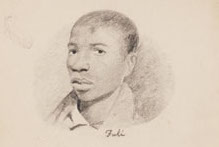Drawings of the Amistad Prisoners, New Haven
Sketched portraits of the Amistad captives as they awaited trial in New Haven.

In 1839, the Spanish slave ship Amistad set sail from Havana to Puerto Principe, Cuba. The ship was carrying 53 Africans who, a few months earlier, had been abducted from their homeland to be sold as slaves. The captives revolted against the ships crew, killing the captain and others, but sparing the life of the ships navigator so that he could set them on a course back to Africa. Instead, the navigator surreptitiously directed the ship north and west. After several weeks, the Amistad was seized by the U.S. Navy off the coast of Long Island and the Africans were transported to New Haven to await trial for mutiny, murder, and piracy.
Slavery advocates held that the Amistad prisoners were slaves and thus they should be punished for their uprising and immediately returned to Cuba. Abolitionists, on the other hand, argued that though slavery was legal in Cuba, the importation of slaves from Africa had been outlawed; thus, they claimed, the prisoners were not slaves, but freemen who had been kidnapped and thus had every right to escape their captors and even to use violence to do so. The case was important to the proslavery-abolitionist debates that were raging in the U.S., and to the international debates about treaty obligations with regard to slavery and the legality of the international slave trade.
After two years of legal battles, their case was successfully argued before the U.S. Supreme Court in 1841 by former President John Quincy Adams and the Amistad captives were freed. They returned to Sierra Leone in 1842.
History of the Collection
New Haven resident William H. Townsend made pencil sketches of the Amistad captives while they were awaiting trial. Twenty-two of these drawings were given to Yale in 1934 by Asa G. Dickerman, whose grandmother was the artist’s cousin. Townsend, who was about 18 years old when he made the drawings, is buried in the Grove Street Cemetery in New Haven, Connecticut, beside the Yale University campus.
The Collection
22 pencil drawings by William H. Townsend (1822-1851), varying in size, 18.3 x 14 cm. and smaller.